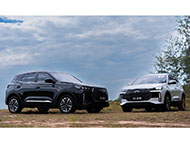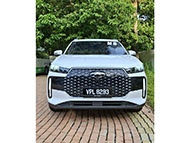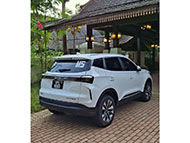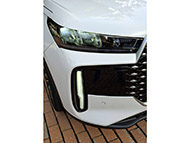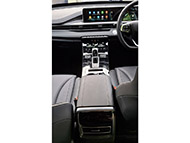By Lee Pang Seng
POWER or mileage is very much to the individual though we believe most would like to stretch the petrol ringgit, especially with the impending removal of fuel subsidy. Nevertheless, it remains a pertinent point and the latest Chery Tiggo Cross provides an answer to either preference.
When Chery Malaysia introduced the Tiggo Cross in early July, two variants were made available. A turbocharged version for those wanting a bit of kick in their driving and the hybrid version, or what Chery calls the CSH – Chery Super Hybrid - for those desiring strong initial acceleration and good mileage.
And being locally assembled, like the bigger Tiggo models (Pro 7 and Pro 8), in the Inokom factory in Kulim, Kedah, the Tiggo Cross is made available at very competitive prices under RM100,000. The Tiggo Cross Turbo is available for RM88,800 on the road without insurance and the Chery Super Hybrid is just RM11,000 more at RM99,800,
With such attractive prices, it was not surprising that the first 500 vehicles were quickly snapped up and we were told that most, if not all, of the remaining 2000 Tiggo Cross variants being assembled were already booked. While the first 500 variants saw about a 50:50 selection between the two models, those for the remaining CKD (complete knock down) variants are said to lean more towards the CSH variant.
It is rather obvious that most Malaysian private car owners prefer to have a vehicle that provides good mileage. After all, with punchy initial electric power, acceleration is strong as you drive off from the traffic lights, allowing you to enjoy some heady performance. In a way, hybrid motoring provides the best of both worlds.
These Tiggo Cross models are powered by 1.5-litre (1498cc) engines; the turbocharged unit puts out 108kW (147PS) and 210Nm and channelling power to the front wheels is a six-speed DCT (dual clutch transmission). It does 0-100km.h in 10.3 seconds in Sports mode and Chery says its average fuel mileage is 6.3L/100 (15.8km/l).
The Tiggo Cross CSH’s engine, as expected, produces a far lower output of 70.5kW (96PS) and 120Nm. As a hybrid, it comes with a 1.8kWh lithium-ion phosphate battery that powers an electric motor that drives the front wheels; its output is far superior to that of the turbo engine at 150kW (204PS) and 310Nm. This explains why it is quicker in accelerating from 0 to 100km/h in 8.9 seconds. It has a high-density Dedicated Hybrid Transmission (DHT). And of course, the average mileage is better too at 5.4L/100km (18.5km/l).
This power scenario is a very big step from the Tiggo 1.6 we drove in 2009. Back then, the engine was not internally developed but sourced externally. It certainly didn’t measure up to expectation with its lack of grunt and rough engine operation. The 1.5-litre engine in the Tiggo Cross today performs well up to mark in their respective mechanical format.
That is the conclusion we could draw on after a drive between the Klang Valley and Kuala Terengganu that was arranged by Chery Malaysia. We also like the way the drive was carried out. There was no convoy driving and we were left to drive at our own pace with the condition that we met at scheduled places for food and refuelling.
The latter stop was due to the exuberance that some media people had driven the Tiggo Cross Turbo. The more robust the pace, the quicker the fuel level drops. As for the hybrid variant, Chery Malaysia decided to put us to the test on achieving the best mileage possible. While others put in extra effort to extract the highest mileage, we decided to see how an ordinary Tiggo Cross owner would get driving normally.
That meant we followed the speed limit for the respective section of the route. There was no hard acceleration but gentle and progressive application, for our part, that is. We were allotted three media people to a vehicle and our two ‘partners’ used the adaptive cruise control as they were more familiar with such systems.
We observed how the cruise control system managed the hybrid engine operation and sought to do the same using our foot on the accelerator. This was in maintaining electric power flow at around 40 per cent while cruising. In spite of that, we went from 5.1L/100km to 5.9L/100km. As our drive session started from Kuantan (where fuel consumption was at its lowest as the battery was more frequently charged to provide electricity to the electric motor) to the Maran rest stop, it was mostly highway driving.
We could select the power flow display function on the instrument panel as well as the centre info display. The hybrid system operates ‘intelligently’ in five modes – EV (electric vehicle) mode when only electric power is used; Tandem mode when the engine acts as a generator to the battery while it feeds the electric motor to power the wheels; Parallel mode when both the engine and electric motor work together for improved performance and Direct Engine mode when the engine directly drives the vehicle although this only happens above 80km/h.
At the end of our drive, we improved the average fuel consumption especially when we were in city traffic conditions to come closer to the claimed figure of 5.4L/100km. The Cross Tiggo’s fuel consumption was computed over the last 50km and not the entire distance covered as was the case in most other automotive brands.
The drive in Tiggo Cross Turbo was more straightforward; just hit the accelerator pedal and enjoy the pace at which it picked up speed. Although the turbo variant is almost a 100kg lighter than the hybrid at 1468kg, it still lost out on initial acceleration. But on the highway, it was right at home cruising at robust speeds with the engine turning at between 2500 and 3000rpm.
Aerodynamically, the Tiggo Cross’s body design appeared well crafted to knife through the air with minimal turbulence. We didn’t hear much wind noise as we cruised along at a robust pace. Chery sure chose some unusual names for its body details such as the Tiger Claw Inspired LED (light emitting diode) headlamps, Starry Diamond-shaped front grille, Crystal-edged Marker LED daytime running lights (DRL) and Tiger Pattern Inspired LED rear taillight that runs the width of this SUV (sport utility vehicle).
Ride was firm and stable on the highway, thanks to the MacPherson strut front and torsion beam rear suspension system. However, for secondary roads with bumps, potholes and rumble strips, we found it best to carry lower road speeds. We could feel the hardness of the road impacts, which was clearly felt from the rear seats. Although it wasn’t jolting, the hardness coloured our ride comfort somewhat.
Each variant comes with a different size wheel and tyre; the turbo has 18-inch sporty alloy wheels fitted with 215/55 R18 GitiComfort 520 tyres while the hybrid has 17-inch aerodynamic alloy rims with 215/60 R17 Sailun eRange Performance tyres. The recommended tyre pressures are different with those for the turbo set at 230kPa and the hybrid 250kPa.
The Tiggo Cross comes with TPMS (tyre pressure monitoring system) as standard and we could see that the tyre pressures went up slightly as the tyres heated up on the highway drive. The tyre pressure for the hybrid was set to the recommended 250kPa for the fuel consumption run, and the hardness of the road impact was immediately felt.
Chery combined the driver’s instrument panel and centre infotainment display, both 10.25-inch units, for a continuous visual flow of information. It is a neat design and although the info display panel had a touchscreen function, there was also a set of buttons on the centre dashboard for physical selection of some functions such as drive modes and speaker volume.
The Tiggo Cross is clearly a rival for the Honda HR-V, Toyota Corolla Cross and Proton X50 with its body dimensions of 4318mm (overall length), 1830mm (overall width) and 1670mm (overall height). Its wheelbase is 2610mm and that gave adequate stretch room for our legs as a rear seat passenger. There was no mention of the luggage capacity but the space available was more than sufficient for our light overnight bags.
In active and passive safety features, the Tiggo Cross Turbo comes with a full list that includes Rear Collision Warning, Rear Cross Traffic Braking, Lane Departure Prevention, Multi Collision Brake, to name some. The hybrid variant doesn’t have these items but its list is adequate with Rear Cross Traffic Alert, Lane Departure Warning, Forward Collision Warning and Autonomous Emergency Braking.
All told, whether turbo or hybrid, the Tiggo Cross comes across as good value for the attractive prices they are endowed with. And they come with impressive warranty packages too; seven years or up to 150,000km. The hybrid has the additional eight-year warranty or up to 160,000km for the battery power pack, power motor and hybrid control unit.







